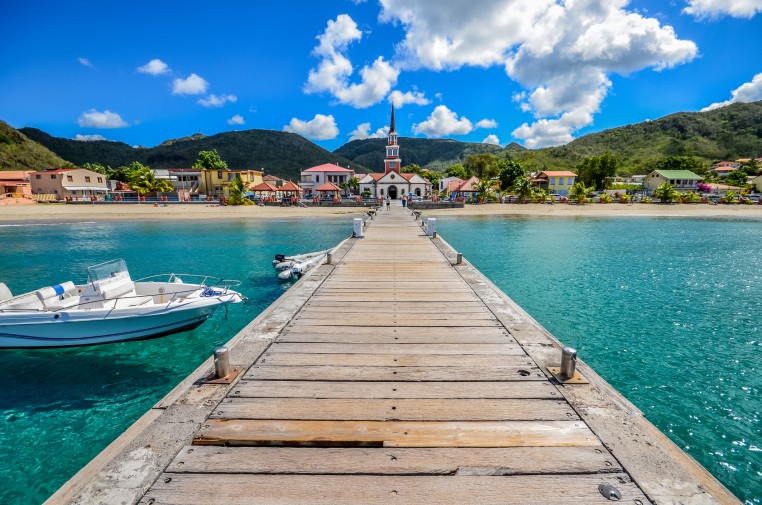
| KEY FACTS | |
|---|---|
| Size | 436 square miles (1,128 square kilometers) |
| Population | 410,000 (80% mixed black, 10% mixed Indian, 5% white, 5% other) |
| Status | overseas French territory |
| Official language(s) | French, Creole |
| GDP per capita (2013) | $22,710 |
| Currency | Euro |
| Electricity | European standard two prong |
| Driving | on the right |
If God was French, he would call paradise Martinique. Colonized by the French in the 17th century, this island is now an integral part of France and as such, it is a territory of the European Union. This means you will need to use Euro as a currency here, electric plugs are of EU standard and most of international flights that arrive here come from Europe. Moreover, everyone on Martinique speaks French, the best restaurants serve French cuisine and the fashion is straight from a Paris’ designer show. Basically, this is where the French vacation, and the reasons for the to do are many more beyond the ones already mentioned.
Martinque is a stunning island consisting of jungle filled mountains and a large volcano in the north as well as extensive plains and drier, rolling hills in the south. It has tens of sandy beaches, each different from the next one, many historic towns, plantations, forts and monuments. At the same time, it is a modern and developed island with a diverse economy, first class tourist amenities and some of the best shopping in the Caribbean. Hence, it is actually slightly surprising that French make as much as 80% of visitors to the island. Yes, the language may be one small obstacle, but Martinique is a welcoming island and many of the residents speak basic English so getting around without knowing the language is not a huge problem. In addition, almost all hotels on the island have English speaking staff and it’s the same with tour companies. Martinique is not a place to ignore – book your visit today!
Getting there
Two airports in North America and one in Europe offer non-stop flights to Martinique all year round. These are Miami, Montreal and Paris. Several other cities on the East Coast also offer direct flights in season (throughout winter) and these are New York, Boston and Washington D.C. All of these flights go to Aime Cesaire International Airport (FDF) located in Le Lamentin just a couple miles away from downtown of the Fort-de-France. The capital city is a popular cruise destination port with most of the big cruise companies having their cruises stop here. Finally, you can get to Martinique via a ferry ride from St.Lucia, Guadloupe and Dominica and the arrival and departure point is Terminal Inter Isles Quai Ouest located in Fort-de-France. The rides are between three to four hours and cost up to 120 euros round trip.
Getting around
Fort-de-France is big on buses and mini-vans. Pointe-Simon is the main bus terminal and it is from where that you can catch a ride to most of the island’s destinations. You can buy tickets at the ticket booths here or directly with a driver (though you will need an exact change). Most tickets will be less than ten euros depending on how far you are going. Interestingly, you can often call your own stop and you will be gladly let off. Compared to using the bus system, renting a car or using taxis is very expensive. However, the good news is that roads, in general, are in good condition here and there are plenty of road signs around as well (though in French!). Although, of course, international rental companies operate from the airport, you are likely to get a better deal from a local car rental company. There are several of them located in the center of Fort-de-France. Finally, just like you take a ferry between Martinique and several other Caribbean islands, you can do the same between several destinations on Martinique. Daily ferries operate between Fort-de-France and Pointe du Bout, Anse-Mitan and Anse-a-l’Ane. A trip between each destination takes less than 30 minutes and tickets are less than ten euros round trip.
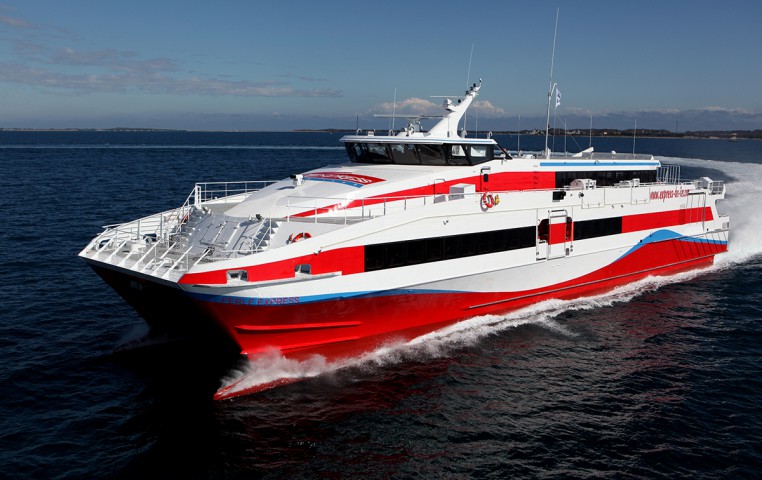
Things to explore
A home to many lovely and quaint fishing villages, Martinique is rich in biodiversity as well as beauty of landscape. It is a tale of two coasts here with the Atlantic side being more rugged and full of cliffs cutting into rough waters of the ocean while the Caribbean side is filled with calm bays and sandy beaches. In the middle of it all sits the large Martinique National Park, which itself covers 2/3 of the island’s landmass. In fact, the park with its Mount Pelée volcano is a is an important motivating factor for many who visit the island. It has tens of trails going through unique examples of fauna and flora as well as leading to some stunning views out to the island and the ocean. The volcano itself, which last erupted in 1902, is an impressive sight from miles away and even more so from close up. What’s more, the Martinique National Park is home to other parks within its borders! One of the most spectacular out of them is Jardin de Balata, a quaint botanical garden with hundreds of exotic plants nested in a jungle valley.

The second most important point of interest on the island would have to be the capital city. Called by many the Paris of the Caribbean, Fort-de-France is full of exclusive shops, restaurants, bars and clubs. In fact, many visitors come to the city just for its wide range of shopping options as this is the place in the Caribbean where you can buy some of the most exquisite designer fashion, jewellery, cosmetics and other luxury goods. Many of the exclusive shops are located between the city town hall and its cruise and bus terminals. This is also where you will find a couple interesting musuems and points of interest like Cathédrale Saint-Louis from 1895, archaeological museum (Musée Départemental d’Archéologie et de Préhistoire de la Martinique) and the Martinique war memorial (of resident of Martinique who died fighting for France) located in a lovely and large park of La Savane. However, probably the most impressive sight of Fort-de-France is Fort St. Louis, which is a large fortress located right on the water and built in the 17th to protect the city. If you get on top of its walls you can get a great view out to Fort-de-France and its neighbourhoods.
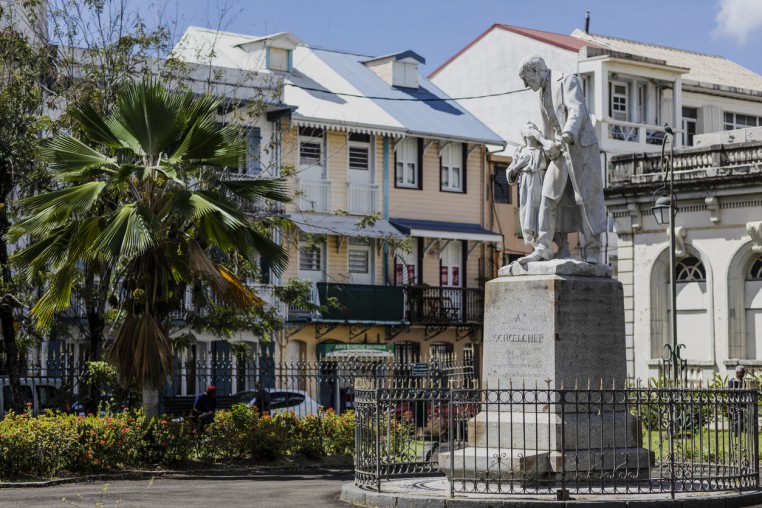
And, the neighbourhoods of Fort-de-France have plenty to offer! Right across from the bay of Fort-de-France is a pretty village of Pointe du Bout, to which you can take a quick ferry from the capital. It has a picturesque marina surrounded by several well-reviewed restaurants as well as a couple quaint beaches where you can relax and swim around in calm waters. Just a couple miles away from Pointe du Bout is Les Trois-Ilets, another pretty town where you can visit the birthplace of Josephine (Napoleon’s wife). And, if you keep going south all the way to the beach town of Le Diamant, you will get to a beach looking out to the famous Diamond Rock, a small, uninhabited island of fascinating history as well as one of the best places in Martinique for divers. Finally, about 45 minute drive east of Le Diamant is the town of Le Marin, which has possibly, the most impressive yachting marina in all of the Caribbean. You will find hundreds of large and small boats here, many of which costing tens of millions of dollars. There are also several great restaurants here lining up the main boulevard.
We mentioned that Martinique is famed for its restaurants several times, but we have not mentioned it is even more renowned for its rum distilleries. One of the top ones is located in St-Pierre, the town which was obliterated in 1902 during the last eruption of Mont Pelee. The Depaz Distillery is located just on the outskirts of town and it is part of a larger plantation that goes back all the way to 17th century. You can do sightseeing, rum tasting and rum buying here. And, while in St-Pierre, you should definitely check out the local cathedral (Cathédrale Notre-Dame de l’Assomption) and zoo (Zoo de Martinique Habitation Latouche). Other well-known rum distilleries on the island are St. James Distillery and Museum in Ste-Anne, Neisson Distillery in Carbet as well as La Distillerie J.M. in Macouba. All of the mentioned distilleries are free to enter and are opened Monday to Saturday except J.M. distillery, which is also opened on Sundays.
Weekends are actually a popular time for Martinique’s locals to hit the beaches. And, they have so many of them to choose from! The town of Le Diamant mentioned earlier is home to one of our favorite stretches of sand with over two miles of uninterrupted beach and crystal clear, though sometimes rough, waters. Also in the south of the island pass St-Anne you can find a large natural area with as many as six stunning wild beaches including Grande Anse de Salines, Petite Anse de Salined, Grande Terre and Anse Meunier. There is also a wildlife park in this area called Savanna of Petrifications with over a mile of trails along a rocky coast. For even more wild and long beaches head south east pass Le Marin to the stunning L’anse de Grand Macabou that spans for over a mile and has a couple trails alongside of it. For more kids and amenities friendly beaches, you can look up Les Salines near Ste-Anne or Anse-Mitan in Pointe du Bout, which is never dull nor quiet and the waters are calm so relaxing in the water is a popular “activity”. All in all, no matter what kind of a beach you like, you can definitely find one that suits you here!
[embedyt]https://www.youtube.com/watch?v=u3yCtvL4-e0[/embedyt]Accommodations
Martinique is dominated by smaller, boutique hotels as well as many apartment rentals. You won’t find huge resorts here with the exception of Club Mec Buccaneer’s Creek in Ste-Anne and L’Hotel la Bateliere in Schoelcher. The first one of these is highly upscale with prices to show for it, whereas the second one is inexpensive, though much outdated. Among the small hotels, there are so many fantastic (and inexpensive!) ones that it would be difficult to list them all on just one page. What makes many of these hotel stand out from competition on other islands, it has to be the many spectacular views, extensive greenery surrounding them, very caring service and low prices for the quality of accommodations offered. The three examples of such hotels are: remote Hotel Plein Soleil in Le Francois with colourful cottages and views out to the sea, Le Domaine Saint Aubin in St-Pierre, also with ocean views which used to be an extensive plantation as well as La Suite Villa in Les Trois-Ilets located on top of a hill and offering panoramic views to the island and the ocean. Overall, one could say Martinique accommodations are best suited for those who want to truly get away. Hence, if you are a couple who are looking for a romantic escape, look no further!
Food & restaurants
It will not be a huge stretch to argue that Martinique has the best quality and diversity of French cuisine in all of the Americas. Many of the French top chefs come here to expand their master skills by mixing French classic tastes with Creole and Caribbean spices. Therefore, you will find many fine dining options here together with, unfortunately, exuberant prices. Luckily, there are also many, many cheap options available throughout the capital and outside of it. A couple of reasonably priced options in Fort-de-France are Le Foyaal Bar and Braserrie, which is a French bistro opened seven days a week and until late at night, charming Le Vieux Foyal with a lovey back garden and extensive cocktail selection and Spice n’ Sugar, which offers delicious Caribbean specialities in large portions. Interestingly, majority of the most exquisite restaurants are located outside of Fort-de-France. If you are a French food connoisseur and have the budget to splurge, check out Le Zandoli in Les Trois-Ilets as well as Le Plein Soleil and Le Belem in Le Francois, which all represent some of the most fine dining experience you can find in all of the Caribbean.
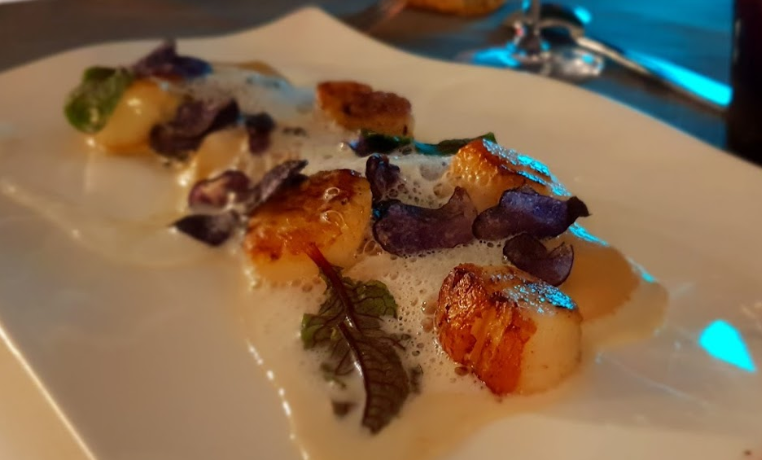
No matter what kind of restaurants you decide to pick, be sure to try some of the local specialities. These include Crabe Farci (stuffed and spicy crab), Boudin Creole (spicy sausage) and Ferice d’avocat (fritters made of cod and avocado). Though of course, you may not want to go to a restaurant for every meal, especially if you rent an apartment with its own kitchen. Here you are in luck as Martinique’s shops and supermarkets are very well stocked with products from all over the Caribbean, Europe as well as from the US. Hence, if staying on budget is crucial, you can save quite a bit of money by buying the various ingredients and cooking for yourself. Keep in mind also, that majority of the larger hotels here include buffet breakfasts in your room price. These are a great deal as food options are extensive and its almost always all you can eat.
Nightlife
Martinique is equally bustling during night time as it is during the day. Clubs and bars are dotted throughout the island with the highest concentrations of them located in and around the capital city. There are at least five dance clubs in Fort-de-France where you can enjoy local zouk and salsa as well as the top 40 list every weekend. Some of the more popular and recommended clubs are Le Negresco, Dream Club and Jet Set. If in addition to dancing, you also wouldn’t mind relaxing in an outdoor bar close to a beach, check out Le Kano Bar Lounge where you can get a table with ocean views and enjoy some great cocktails and local music. And, if you are a connoisseur of cocktails, you cannot miss out on visiting Le Green Impérial in Les Trois-Illets. This is our own personal Caribbean favourite for cocktails and its also a great place to meet locals and tourists alike. Besides being home to many lively bars and clubs, Martinique is also well known throughout the Caribbean for its dance performing troupes like the Grands Ballets de Martinique based in Les Trois-Illets, who give a show at least once a week in the local Hotel Carayou. Finally, don’t forget Martinique’s Carnival occurs every March, which means the island is full of day and night parties throughout the month!
Sports & adventure
Like on most other Caribbean islands, water sports and adventures are the prime activities Martinique visitors and locals participate in. The most important among them are sailing, fishing, kayaking and diving. The top five diving sites are the corals and boulders around Diamond Rock, Le Sous-Marin in the north with many underwater canyons and a submarine shipwreck, Saint Pierre Bay with as many as 15 shipwrecks, Pointe Burgos Reef with a 180-foot wall as well as the well-preserved Nahoon Shipwreck located just outside the bay of Fort-de-France. You will find that many sailing trips (day sails) organized by the local companies stop by these diving spots or on nearby shallow reefs where you can snorkel for hours (in case diving is too much of a hustle). Lastly, Instead of joining a large boat on a day sail, you can also rent a kayak or two and explore many of the local islands and swamps this way. A good deploying point is the town of Le Roert, from which you can kayak to many of the uninhabited islands nearby like Îlet Chancel and Ilet Madame among many others.
For those who rather stay close to shore or right on it, keep in mind most of Martinique is made up of the national park – Parc Naturel Regional de la Martinique. There are over 30 trails here with tens of miles of walking and many paths cutting across the Mount Pelée volcano. Keep in mind hiking here can be difficult so consider going in a bigger group with a local guide. For more dynamic jungle adventures, check out Mangofil zip-line park in Les Trois-Ilets, one of the most extensive and best designed such parks in the Caribbean. Also in Les Trois-Ilets, you will find the Ranch Jack, a large stable right by several forest trails offering daily horseback riding as well as the only 18 hole golf course in Martinique (Golf de I’Imperatrice Josephine).
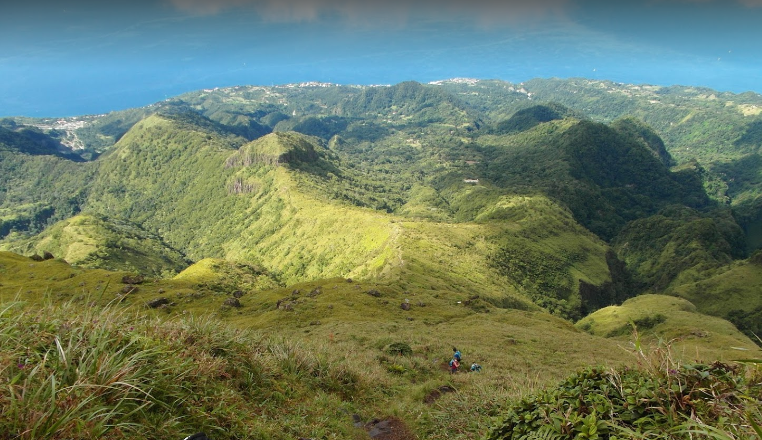
Safety and Security
In many ways, Martinique feels no different than western Europe or the US. It is a safe and stable territory with first class schools, hospitals and emergency services. Crime rate is very low compared to most parts of the Caribbean, though there are parts of Fort-de-France that should be avoided at night time as petty thefts are pretty common there. Go out and travel in groups for extra safety. Also, having someone in your group who speaks French can be very helpful in dubious situations.
